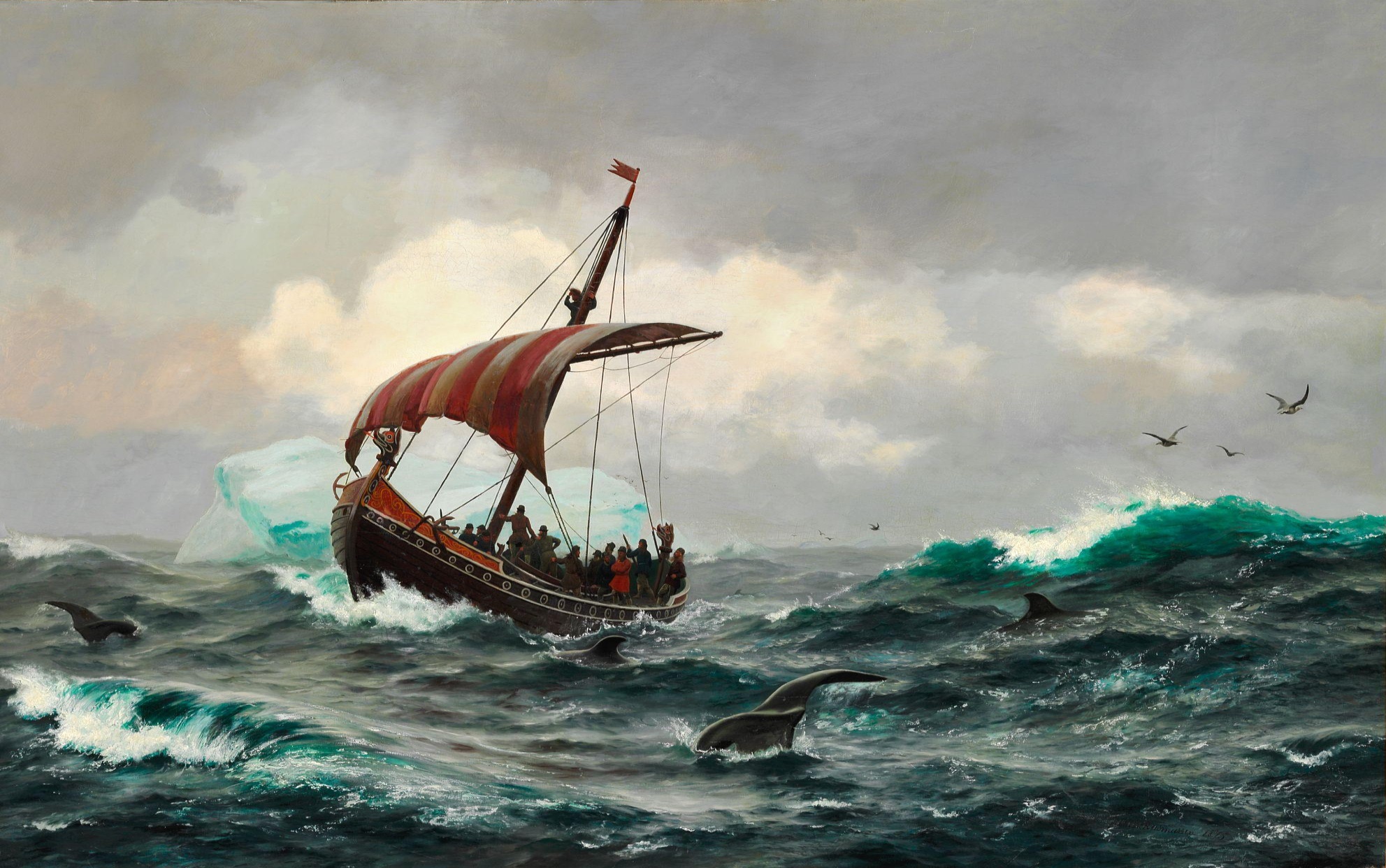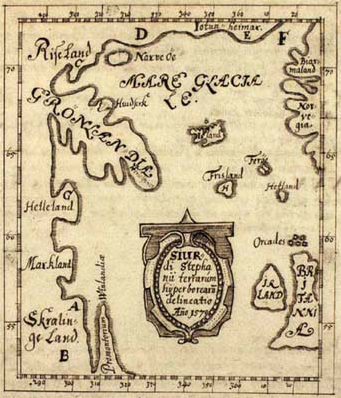1 Leif Erikson (ca. 1000)
The Norse have an old legend that Viking hero Leif Erikson founded a colony in a new land they called Vinland. The discovery of the Norse village in 1960 and its acceptance as a UNESCO World Heritage site in 1978 established the Newfoundland colony as the oldest known European site in the Americas, and very probably as the Vinland settlement of Norse legends. The Canadian ruins date from the appropriate period, around 1000 CE. Artifacts found in the remains of eight buildings include farm implements and spinning and blacksmith tools. It was probably an extension of the permanent Viking settlements on Greenland that were the home of Leif’s father, Erik the Red.

Biarni Heriulfsson came out from Greenland on a visit to Earl Erik, by whom he was well received. Biarni gave an account of his travels [while lost at sea in a fog for several days, he apparently landed in America] when he saw the lands, and the people thought that he had been lacking in enterprise, since he had no report to give concerning these countries; and the fact brought him reproach. Biarni was appointed one of the Earl’s men, and went out to Greenland the following summer. There was now much talk about voyages of discovery. Leif, the son of Erik the Red, of Brattahlid, visited Biarni Heriulfsson and bought a ship of him, and collected a crew, until they formed altogether a company of thirty-five men. Leif invited his father, Erik, to become the leader of the expedition, but Erik declined, saying that he was then stricken in years, and adding that he was less able to endure the exposure of sea life than he had been. Leif replied that he would nevertheless be the one who would be most apt to bring good luck and Erik yielded to Leif’s solicitation, and rode from home when they were ready to sail.
When he was but a short distance from the ship, the horse which Erik was riding stumbled, and he was thrown from his back and wounded his foot, whereupon he exclaimed, “It is not designed for me to discover more lands than the one in which we are now living, nor can we now continue longer together.” Erik returned home to Brattahlid, and Leif pursued his way to the ship with his companions, thirty-five men. One of the company was a German, named Tyrker. They put the ship in order; and, when they were ready, they sailed out to sea, and found first that land which Biarni and his shipmates found last. They sailed up to the land, and cast anchor, and launched a boat, and went ashore, and saw no grass there. Great ice mountains lay inland back from the sea, and it was as a [tableland of] flat rock all the way from the sea to the ice mountains; and the country seemed to them to be entirely devoid of good qualities. Then said, Leif “It has not come to pass with us in regard to this land as with Biarni, that we have not gone upon it. To this country I will now give a name and call it Helleland [the land of flat rocks].”

They returned to the ship, put out to sea, and found a second land. They sailed again to the land, and came to anchor, and launched the boat, and went ashore. This was a level wooded land; and there were broad stretches of white sand where they went, and the land was level by the sea. Then said Leif, “This land shall have a name after its nature; and we will call it Markland [land of forests].” They returned to the ship forthwith, and sailed away upon the main with north-east winds, and were out a full day before they sighted land. They sailed toward this land and came to an island which lay to the northward off the land. There they went ashore and looked about them, the weather being fine, and they observed that there was dew upon the grass, and it so happened that they touched the dew with their hands, and touched their hands to their mouths, and it seemed to them that they had never before tasted anything so sweet as this. They went aboard their ship again and sailed into a certain sound, which lay between the island and a cape, which jutted out from the land on the north, and they stood in westering past the cape. At ebb-tide, there were broad reaches of shallow water there, and they ran their ship aground there, and it was a long distance from the ship to the ocean; yet were they so anxious to go ashore that they could not wait until the tide should rise under their ship, but hastened to the land, where a certain river flows out from a lake. As soon as the tide rose beneath their ship, however, they took the boat and rowed to the ship, which they conveyed up the river, and so into the lake, where they cast anchor and carried their hammocks ashore from the ship and built themselves cabins there.
They afterward determined to establish themselves there for the winter, and they accordingly built a large house. There was no lack of salmon there either in the river or in the lake, and larger salmon than they had ever seen before. The country thereabouts seemed to be possessed of such good qualities that cattle would need no fodder there during the winters. There was no frost there in the winters, and the grass withered but little. The days and nights there were of more nearly equal length than in Greenland or Iceland. On the shortest day of winter, the sun was up between 7:30 and 3:30 [suggesting a latitude of about 50°]. When they had completed their house, Leif said to his companions, “I propose now to divide our company into two groups, and to set about an exploration of the country. One-half of our party shall remain at home at the house, while the other half shall investigate the land; and they must not go beyond a point from which they can return home the same evening, and are not to separate [from each other]. Thus they did for a time. Leif, himself, by turns joined the exploring party, or remained behind at the house. Leif was a large a powerful man, and of a most imposing bearing; a man of sagacity, and a very just man in all things.
Erik the Red also died that winter. There was now much talk about Leif’s Vinland journey; and his brother, Thorvald, held that the country had not been sufficiently explored. Thereupon Leif said to Thorvald, “If it be thy will, brother, thou mayest go to Vinland with my ship.” And so it was done.
They were soon provided with an abundant and goodly supply of food; for a whale of good size and quality was driven ashore there, and they secured it, and flensed it, and had then no lack of provisions. The cattle were turned out upon the land, and the males soon became very restless and vicious: they had brought a bull with them. Karlsefni caused trees to be felled and to be hewed into timbers wherewith to load his ship, and the wood was placed upon a cliff to dry. They gathered somewhat of all of the valuable products of the land: grapes, and all kinds of game and fish, and other good things. In the summer succeeding the first winter Skrellings were discovered. A great troop of men came forth from out the woods. The cattle were hard by, and the bull began to bellow and roar with a great noise, whereat the Skrellings were frightened, and ran away with their packs, wherein were gray furs, sables, and all kinds of pelts. They fled towards Karlsefni’s dwelling and sought to effect an entrance into the house; but Karlsefni caused the doors to be defended [against them].
Source: Leif Erikson’s Discovery of America, from the Saga of Erik the Red (1387) in American historical documents, 1000-1904: with introductions and notes. New York: P.F. Collier, c1910. The Harvard Classics v. 43. https://sourcebooks.fordham.edu/mod/1000Vinland.asp
